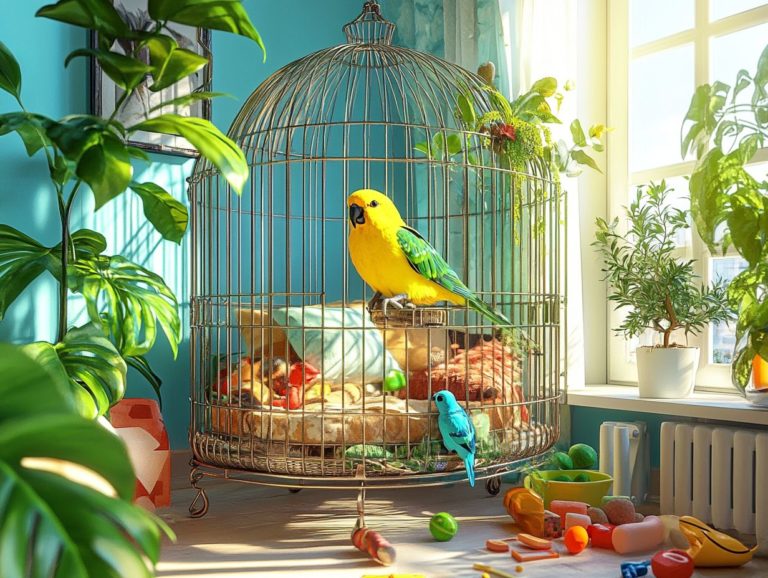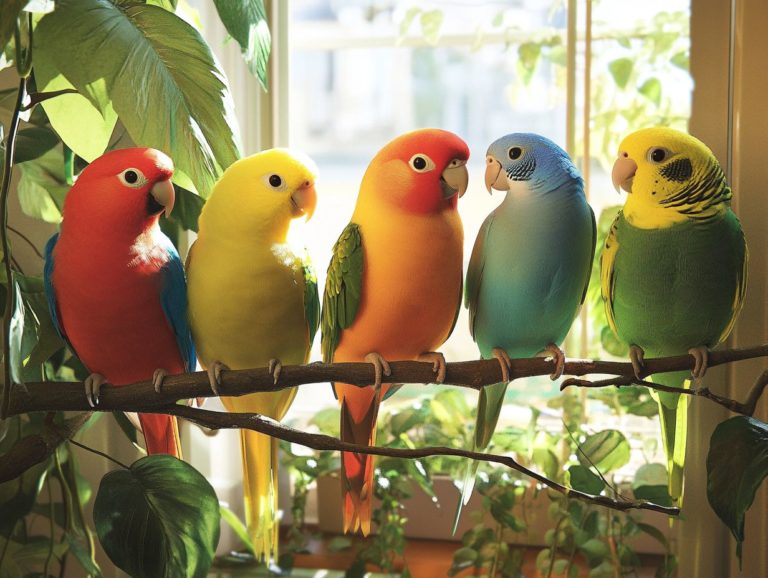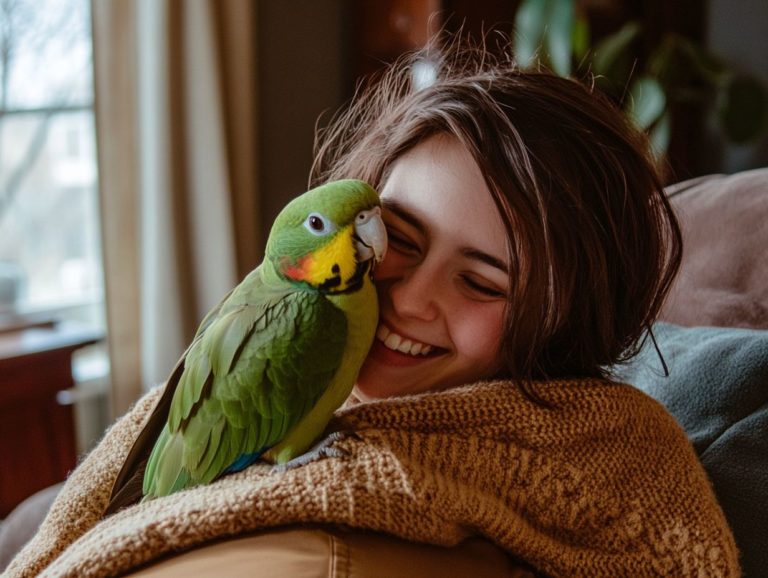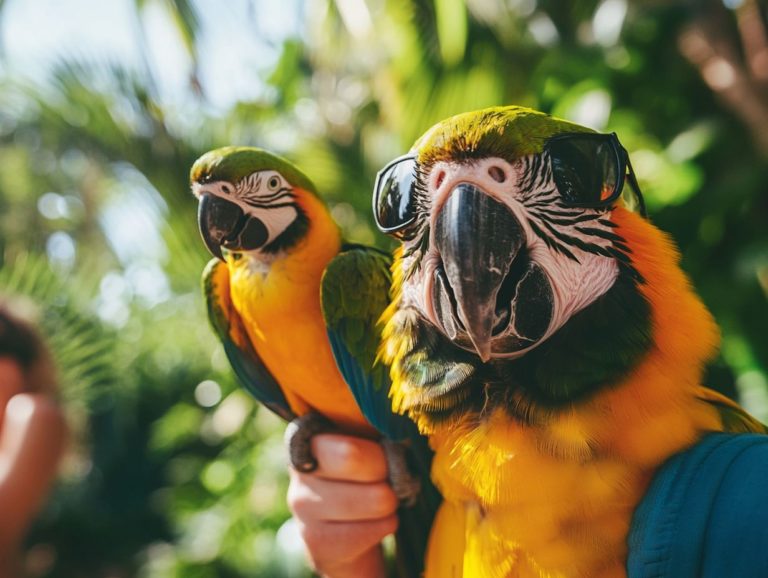Bird Adoption: What to Do When You First Adopt
Adopting a bird, especially a parrot, can be an incredibly rewarding experience, but it comes with unique responsibilities regarding their care and welfare.
Whether you re a seasoned bird enthusiast or stepping into pet ownership for the first time, understanding bird adoption is crucial.
This guide will walk you through important factors to consider before welcoming a feathered friend into your home, outline the adoption process, and offer practical tips for integrating your new pet into your life.
You ll discover how to build a lasting bond, handle common issues, and ensure your bird remains healthy and happy.
Get ready for an exciting adventure as you welcome a feathered friend into your life!
Contents
Key Takeaways on Bird Adoption:
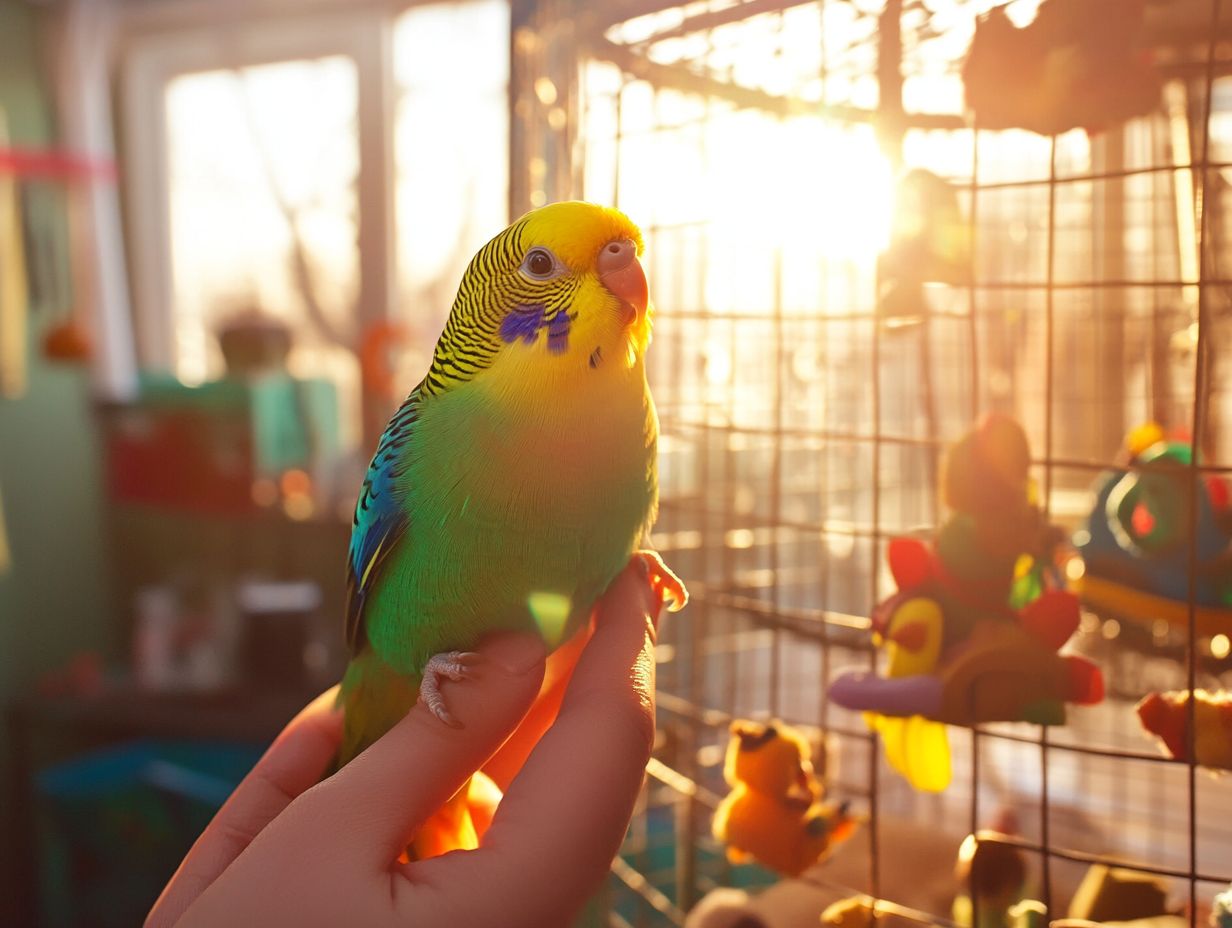
- Before adopting a bird, research factors like lifespan, behavior, and space needs for a successful, long-term adoption.
- The adoption process involves finding a reputable source, preparing a suitable living space, and gradually introducing the bird to your household.
- To establish a strong bond, focus on building trust and communication through positive reinforcement and quality time together.
Preparing for Bird Adoption
Preparing for bird adoption is a big commitment that requires careful thought about various factors, especially when adopting a parrot, known for its intelligence and sensitivity. It’s also important to consider creating a bird-friendly environment after adoption to ensure a smooth transition.
Bringing a bird into your home goes beyond meeting its care and behavioral needs; it involves creating an environment that supports its well-being. You must assess your readiness to provide essential support and resources for the parrot’s emotional and physical health.
This includes understanding different species, their lifespans, and their unique behaviors.
What to Think About Before Bringing Home a Bird
Before welcoming a bird into your life, especially a parrot or another species, consider several factors that will impact your new feathered friend and your household dynamics, particularly regarding socialization and interaction.
Be aware that birds have unique behaviors, such as biting or excessive vocalization. These often result from insufficient socialization or an environment that doesn t meet their needs. Understanding these traits is key to fostering a harmonious living situation.
Birds are social creatures that thrive on interaction. Building trust through consistent engagement is vital for forming a strong bond.
Rescue groups emphasize the importance of patience and dedication in this journey. They show how past interactions can shape a bird’s behavior. Many adoptees undergo remarkable transformations once they receive the love and attention they deserve, illustrating the commitment required for responsible bird ownership. For more insights, check out how to give your adopted bird a happy home.
Adoption Process
The journey of adopting a new bird, like a parrot, is a thoughtful process filled with essential steps. While these steps may vary depending on the shelter or rescue organization you choose, the importance of commitment and proper training cannot be overstated.
Steps to Take Before, During, and After Adoption
Before, during, and after welcoming a bird into your life, it’s crucial to follow specific steps to ensure a smooth transition and to understand what you should know about bird adoption to create a nurturing environment for your new companion.
Start by preparing a safe and comfortable living space, complete with an appropriately sized cage, perches, and engaging toys to stimulate your bird’s mind. To ensure a smooth transition, it’s important to learn how to help a bird in need before adoption. Once the environment is ready, introducing the bird to your household members is essential; gradual introductions will help minimize stress, allowing your feathered friend to acclimate at its own pace.
Establishing training routines early on will lay the foundation for effective communication and bonding. Regular cleaning is vital for hygiene, keeping the space healthy and preventing potential behavioral issues. Ongoing interaction and positive reinforcement will further strengthen your bond, ensuring your bird feels secure and cherished in its new home.
Welcoming Your New Bird Home
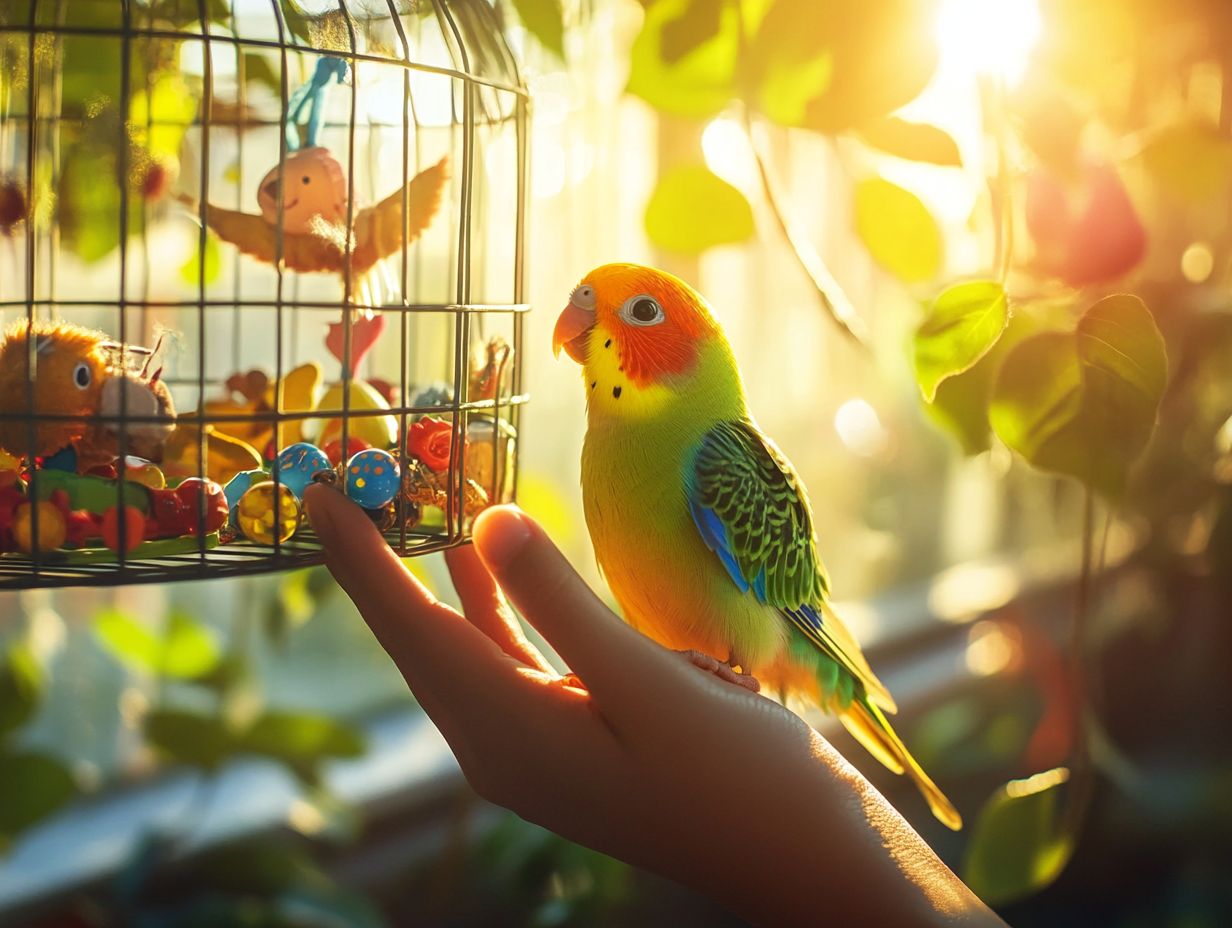
Welcoming a new bird, like a parrot or conure, into your home is an exhilarating experience! It’s essential to craft an environment that fosters socialization, builds trust, and facilitates a smooth adjustment period for your new companion.
Setting Up Their Living Space
Setting up a perfect home for your new bird is crucial! It will greatly enhance their happiness and well-being.
To ensure your avian companion thrives, selecting an appropriately sized cage is crucial. For species like parakeets or cockatiels, a size of at least 24 x 24 x 36 inches is generally recommended. The cage should be placed in a quiet yet social area of your home, away from drafts and direct sunlight, allowing your bird to feel part of the family while observing daily activities.
Incorporating a variety of toys think bells, swings, and foraging puzzles (toys that encourage birds to search for treats) stimulates their imagination and encourages physical activity. Safety is key; ensure the cage has no sharp edges and is free from toxic materials. Regular cleaning prevents disease. It s essential for your bird s health. Routine environmental enrichment boosts your bird’s mental capabilities, contributing to their overall health and happiness.
Introducing Them to Your Household
Introducing your new bird to your home is a journey that requires both patience and thoughtful planning. This careful approach builds trust. It also helps your bird socialize smoothly.
Creating a safe and secure environment is essential, allowing your bird to acclimate at its own pace. Start by letting it explore its new cage, filled with a variety of toys and perches to promote comfort and curiosity.
When family members are ready to meet the bird, introduce them gradually. Encourage soft voices and gentle movements to avoid overwhelming your new companion.
If you have other pets, like dogs or cats, it s important to supervise their interactions closely. Maintain a calm atmosphere to ease any potential tensions. Reinforce the idea that patience and respect are key during this critical adjustment period.
Establishing a Bond with Your Bird
Establishing a connection with your bird, especially with a sensitive and intelligent species like the parrot, is essential. This bond not only fosters trust but also enhances communication, paving the way for a truly fulfilling relationship.
Building Trust and Communication
Building trust and effective communication with your bird is essential for forging a strong bond, especially with social species like parrots.
Engaging in consistent interactions lays the foundation for a lasting relationship, enhancing both companionship and joy. Gentle training techniques play a vital role in this journey, creating an environment where your bird feels safe and valued.
By understanding your bird’s behavioral cues such as vocalizations, body language, and postures you can respond to its unique communication style more effectively. Recognizing these signals allows for a deeper connection, fostering mutual understanding that encourages trust and cultivates a harmonious living experience.
Common Challenges and Solutions
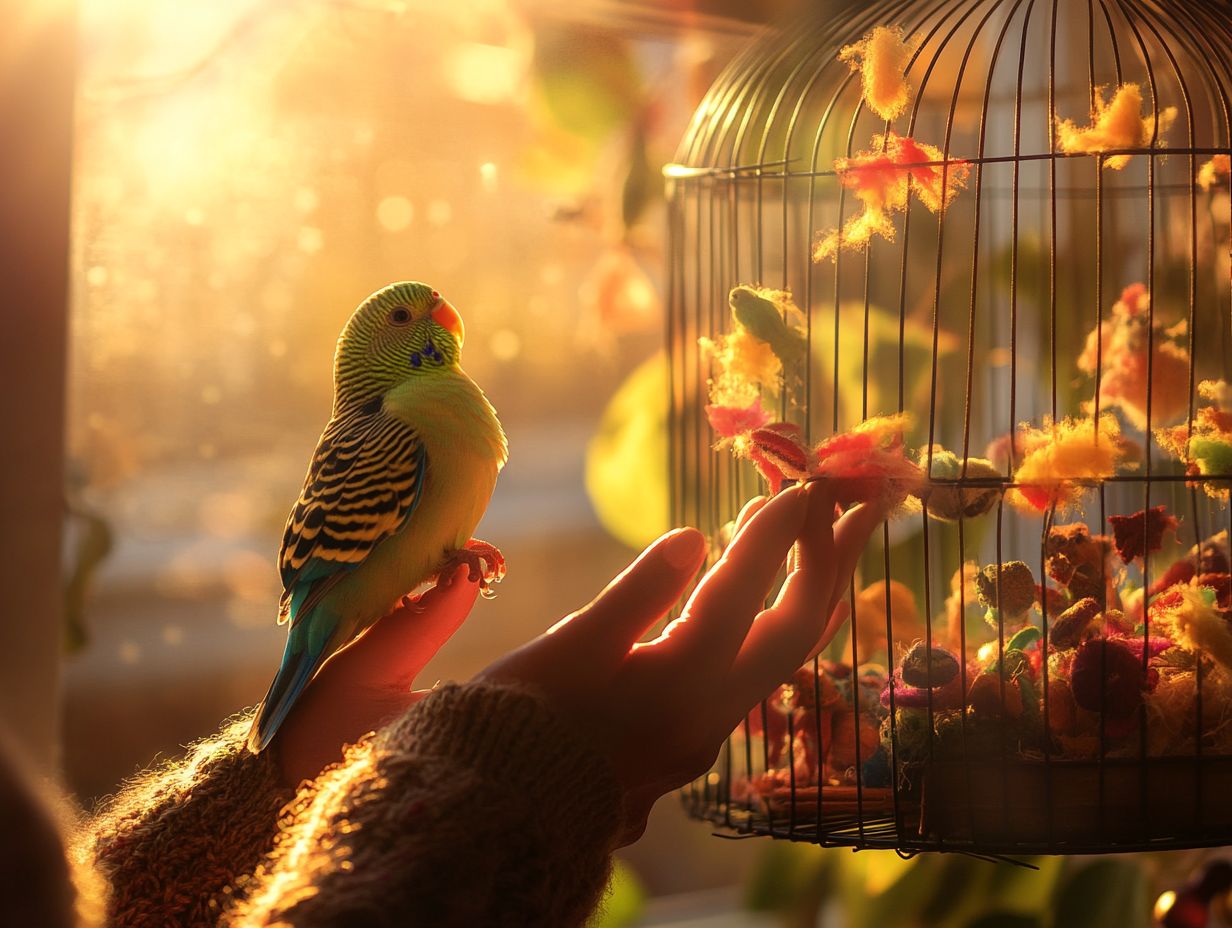
Adopting a bird, particularly a parrot, presents its own set of challenges that often revolve around behavioral issues and emotional needs. This journey requires your understanding, patience, and the implementation of socialization tips for newly adopted birds to foster a harmonious relationship.
Get ready to welcome your new bird! Prepare its home today for the best start.
Addressing Behavioral Issues
Addressing behavioral issues in your new bird requires a thoughtful approach. Blend training techniques with patience to cultivate a harmonious relationship.
Fearfulness can manifest in various ways, creating stress for both you and your feathered friend. It s essential to understand the root cause of these behaviors, whether it s a lack of socialization or past trauma.
Consistency in training sessions builds trust and strengthens your bond. Gradually introducing your bird to new environments or different people can help ease its fears.
Using simple methods like rewarding good behavior encourages progress. Remember, patience is crucial; your efforts to nurture and reassure will lead to improved behavior and a more confident, well-adjusted companion.
Maintaining a Happy and Healthy Bird
To maintain a happy and healthy bird, like a parrot or macaw, commit to providing proper care, balanced nutrition, and enriching activities. These elements stimulate both their mental and emotional well-being.
It’s not just about feeding them; it s about creating an environment where they can thrive and express their vibrant personalities.
Essential Care Tips for Your Feathered Friend!
Proper care and nutrition are fundamental to the health and welfare of your bird. Grasping their specific dietary needs and daily care routines is essential.
Each species has its own unique dietary preferences that must be catered to for optimal health. For instance, seed-eating birds might thrive on high-quality pellets, while others benefit from fresh fruits and vegetables.
Offer a variety of foods to ensure they receive all necessary nutrients. Always provide clean, fresh water, as hydration is vital for their well-being.
Be conscious of portion sizes to prevent obesity or undernutrition. A balanced diet plays a significant role in promoting longer, healthier lives for your feathered companions.
Frequently Asked Questions
What should I do when I first adopt a bird?
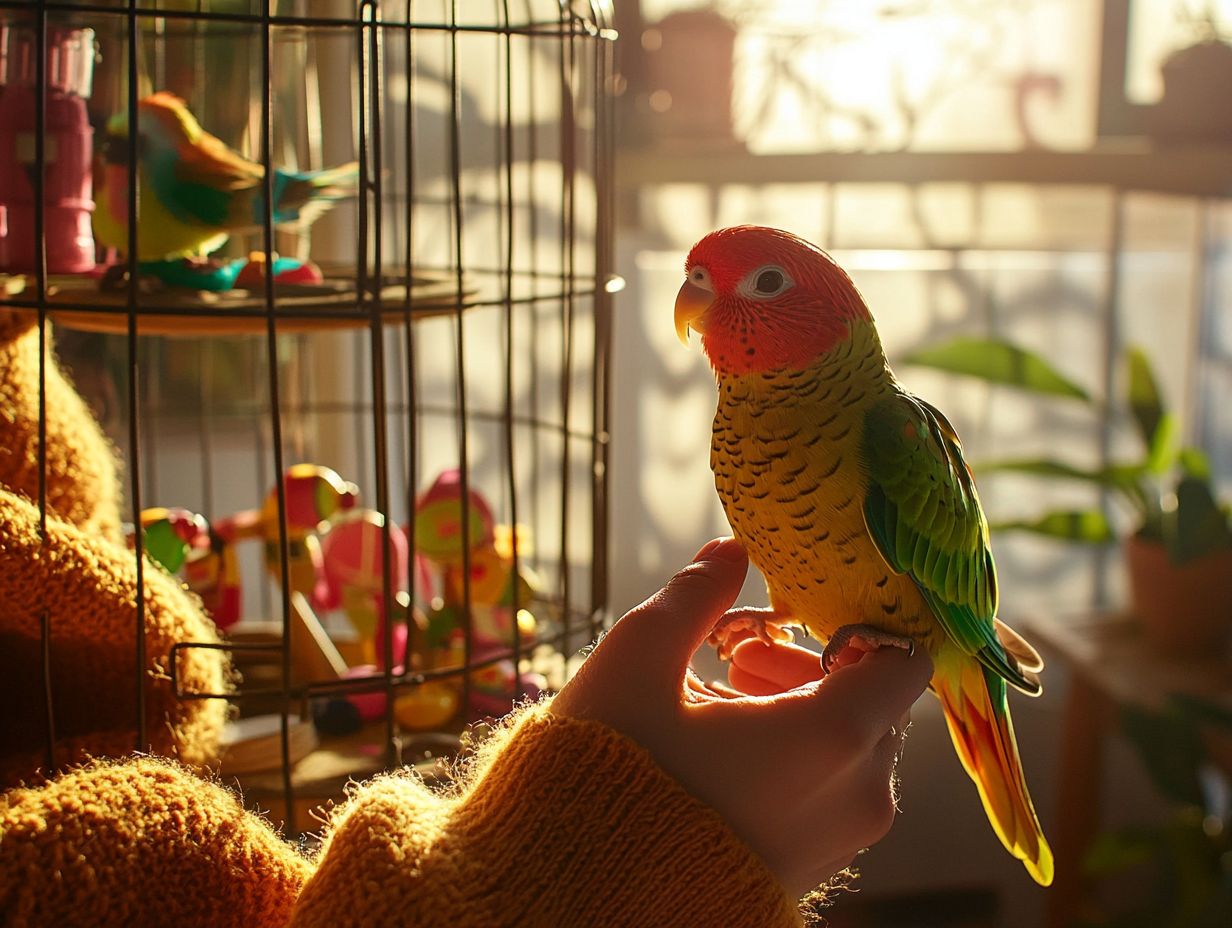
When you first adopt a bird, ensure they have a safe and comfortable environment. Understanding the bird adoption process can also help you provide a proper cage, perches, and toys for stimulation.
How can I bond with my newly adopted bird?
Birds are social animals that enjoy spending time with their owners. Spend time talking to and playing with your bird to help establish a bond.
Offer treats as rewards for good behavior to strengthen your connection.
What should I feed my newly adopted bird?
Research the specific dietary needs of your bird’s species. Generally, a balanced diet includes fresh fruits and vegetables, high-quality pellets, and occasional treats like seeds or nuts.
How can I help my bird adjust to their new home?
When bringing your bird home, keep them in a quiet and calm environment. This will help them adjust without feeling overwhelmed.
Avoid handling your bird too much or introducing them to other pets too soon.
Should I take my newly adopted bird to the vet?
Yes, it’s recommended to take your bird to a veterinarian soon after adoption. A vet can perform a general check-up and ensure your bird is healthy, as outlined in the emotional journey of bird adoption.
They can also provide important information on proper care and any necessary vaccinations.
What should I do if my newly adopted bird seems stressed or scared?
Birds can be sensitive and easily stressed in new environments. Give them time to adjust and provide plenty of love and attention.
If your bird continues to show signs of stress or fear, consult with a veterinarian or a bird behavior specialist for additional tips and advice.


